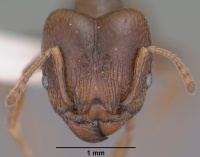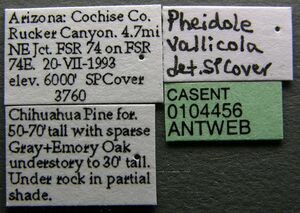Pheidole vallicola
| Pheidole vallicola | |
|---|---|

| |
| Scientific classification | |
| Kingdom: | Animalia |
| Phylum: | Arthropoda |
| Class: | Insecta |
| Order: | Hymenoptera |
| Family: | Formicidae |
| Subfamily: | Myrmicinae |
| Tribe: | Attini |
| Genus: | Pheidole |
| Species: | P. vallicola |
| Binomial name | |
| Pheidole vallicola Wheeler, W.M., 1915 | |
Stefan Cover (unpublished collection notes) found vallicola to favor creek banks and open woodland with a wide range of species composition, from ponderosa pine to oak, pine-oak-juniper, and oak-mesquite-sumac. (Wilson 2003)
Identification
The major of this species can be recognized by the flattened region at the base of the scape, as well as by the elongate scape, which reaches at least 3/4 of the distance between its insertion and the posterior margin of the posterior lateral lobe. The posterior half of the posterior lateral lobe is moderately to strongly shining. The dorsum of the head of the minor worker is densely punctate and opaque, erect hairs on the gaster of the major are sparse and widely spaced. (Mackay and Mackay 2002)
Also see the description in the nomenclature section.
Keys including this Species
Distribution
Recorded by Stefan Cover in numerous collections at 1200–1900 m in the following mountain ranges of southeastern Arizona: Chiricahua, Dragoon, Huachuca, Pajarito, Pinal, and Sierra Ancha. (Wilson 2003) Mackay and Mackay (2002) also report this species occurring in New Mexico.
Latitudinal Distribution Pattern
Latitudinal Range: 34.912517° to 29.2°.
| North Temperate |
North Subtropical |
Tropical | South Subtropical |
South Temperate |
- Source: AntMaps
Distribution based on Regional Taxon Lists
Nearctic Region: United States (type locality).
Neotropical Region: Mexico.
Distribution based on AntMaps
Distribution based on AntWeb specimens
Check data from AntWeb
Countries Occupied
| Number of countries occupied by this species based on AntWiki Regional Taxon Lists. In general, fewer countries occupied indicates a narrower range, while more countries indicates a more widespread species. |

|
Estimated Abundance
| Relative abundance based on number of AntMaps records per species (this species within the purple bar). Fewer records (to the left) indicates a less abundant/encountered species while more records (to the right) indicates more abundant/encountered species. |

|
Biology
This species nests under stones in rocky loam soils. Brood was found in nests in July. Seeds are stored in nests. (Mackay and Mackay 2002)
Castes
Worker
Minor
Images from AntWeb
   
| |
| Worker. Specimen code casent0104456. Photographer Jen Fogarty, uploaded by California Academy of Sciences. | Owned by CAS, San Francisco, CA, USA. |
Nomenclature
The following information is derived from Barry Bolton's Online Catalogue of the Ants of the World.
- vallicola. Pheidole crassicornis subsp. vallicola Wheeler, W.M. 1915b: 409 (s.w.) U.S.A. Raised to species: Creighton, 1950a: 191. See also: Wilson, 2003: 162.
Unless otherwise noted the text for the remainder of this section is reported from the publication that includes the original description.
Description
From Wilson (2003): A member of the crassicornis group, similar to Pheidole crassicornis, Pheidole diversipilosa, Pheidole porcula and Pheidole tetra, but differing by the following combination of traits.
Major: pilosity consisting of sparse, very long hairs (some on first gastral tergite are 2! the maximum eye length); head in side view tapered toward occiput; rugoreticulum forms a broad swath from antennal fossa to eye on each side; carinulae along midline of dorsum of head continue to occiput; pronotum sparsely foveolate and feebly shining on sides, smooth and shiny on dorsum; postpetiole from above laterally subangulate.
Minor: petiolar node from side thin, and tapered toward apex; pilosity sparse, as illustrated; dorsum of head (except for frontal triangle and middle section of clypeus), all of mesosoma, and most of waist foveolate and opaque.
MEASUREMENTS (mm) Lectotype major: HW 1.34, HL 1.44, SL 0.80, EL 0.20, PW 0.64. Paralectotype minor: HW 0.64, HL 0.70, SL 0.82, EL 0.14, PW 0.44.
COLOR Major: body light reddish brown except for gaster, which is a slightly contrasting medium reddish brown.
Minor: concolorous medium reddish brown.
Figure. Upper: lectotype, major. Lower: paralectotype, minor. Scale bars = 1 mm.
Type Material
ARIZONA: Miller Canyon, Huachuca Mts., southeastern Arizona, col. W. M. Wheeler. Museum of Comparative Zoology - as reported in Wilson (2003)
Etymology
L vallicola, valley dweller, referring to the habitat of the type colony. (Wilson 2003)
References
- Creighton, W. S. 1950a. The ants of North America. Bulletin of the Museum of Comparative Zoology 104: 1-585 (page 191, raised to species)
- Mackay, W. P. and E. Mackay. 2002. The ants of New Mexico (Hymenoptera: Formicidae). Edwin Mellen Press, Lewiston, NY.
- Wheeler, W. M. 1915b. Some additions to the North American ant-fauna. Bull. Am. Mus. Nat. Hist. 34: 389-421 (page 409, soldier, worker described)
- Wilson, E. O. 2003. Pheidole in the New World: A dominant, hyperdiverse ant genus. Harvard University Press, Cambridge, MA. (page 162, fig. major, minor described)
References based on Global Ant Biodiversity Informatics
- Cover S. P., and R. A. Johnson. 20011. Checklist of Arizona Ants. Downloaded on January 7th at http://www.asu.edu/clas/sirgtools/AZants-2011%20updatev2.pdf
- Johnson R. Personnal Database. Accessed on February 5th 2014 at http://www.asu.edu/clas/sirgtools/resources.htm
- Mackay W. P. and Mackay, E. E. 2002. The ants of New Mexico (Hymenoptera: Formicidae). Lewiston, New York: Edwin Mellen Press, 400 pp.
- O'Keefe S. T., J. L. Cook, T. Dudek, D. F. Wunneburger, M. D. Guzman, R. N. Coulson, and S. B. Vinson. 2000. The Distribution of Texas Ants. The Southwestern Entomologist 22: 1-92.
- Van Pelt, A. 1983. Ants of the Chisos Mountains, Texas (Hymenoptera: Formicidae) . Southwestern Naturalist 28:137-142.
- Wilson, E.O. 2003. Pheidole in the New World: A Dominant, Hyperdiverse Genus. Harvard University Press


